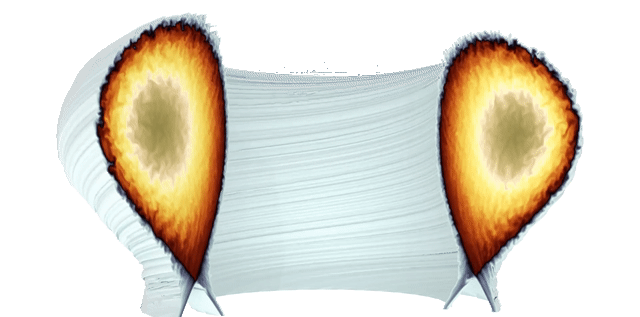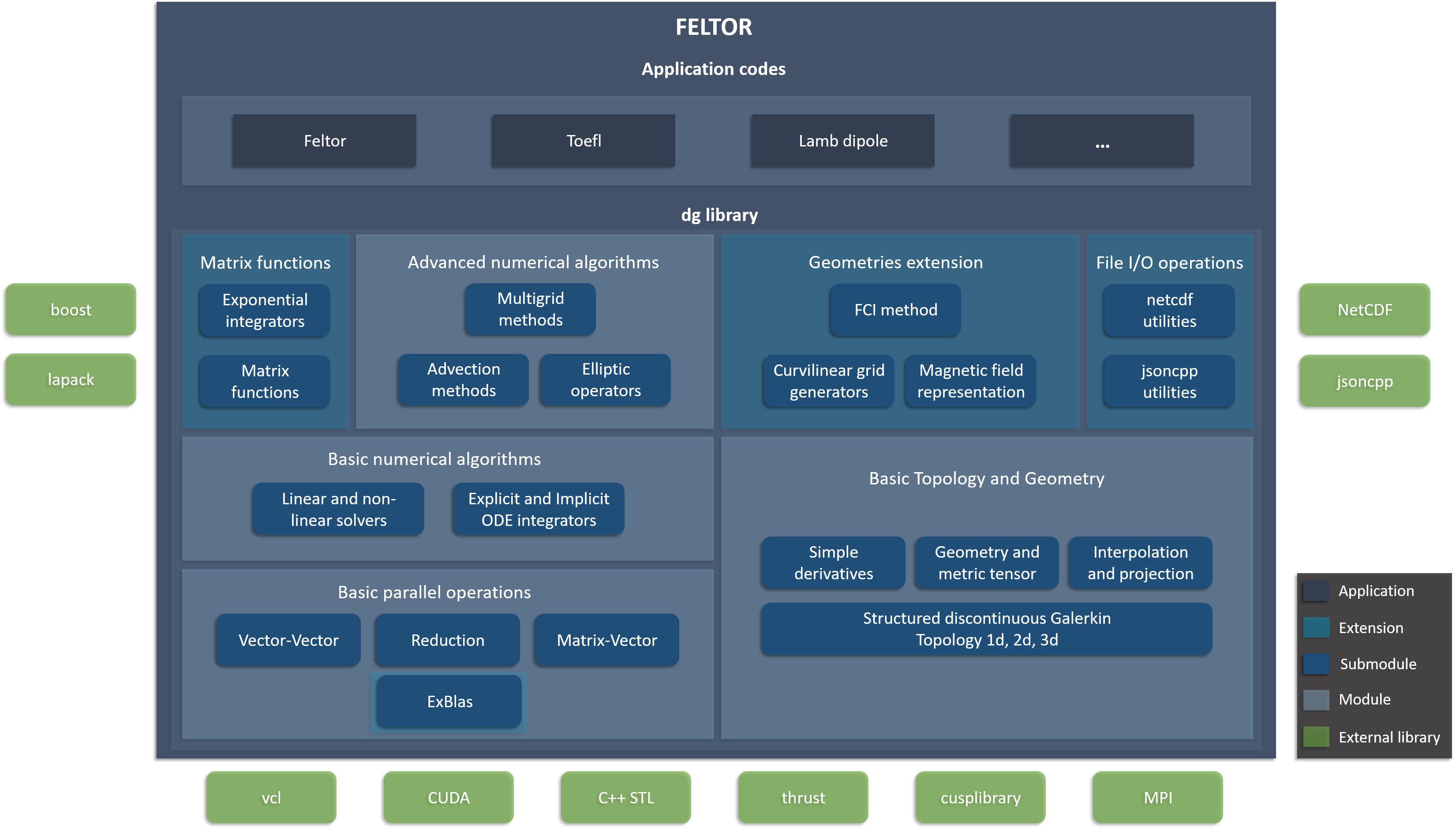About
FELTOR (Full-F ELectromagnetic code in TORoidal geometry) is a modular scientific software project used for:
 Physics: study fluid models for magnetised (fusion) plasmas in one, two and three dimensions
Physics: study fluid models for magnetised (fusion) plasmas in one, two and three dimensions
 Numerics: develop and study numerical methods for these models in particular novel discontinuous Galerkin methods and structured grid generators
Numerics: develop and study numerical methods for these models in particular novel discontinuous Galerkin methods and structured grid generators
 High performance computing: investigate parallel peformance, binary reproducibility and accuracy of the above algorithms on modern hardware architectures.
High performance computing: investigate parallel peformance, binary reproducibility and accuracy of the above algorithms on modern hardware architectures.
FELTOR applications run on a large variety of hardware from laptop CPUs to GPUs to high performance compute clusters.
 FELTOR has been developped for more than 10 years and is still growing today with new application codes emerging from current research.
Among the application codes is the FELTOR code, a simulation code for three-dimensional gyro-fluid plasma turbulence in toroidal geometry, which is the main driver, motivator and name-giver of the project.
FELTOR has been developped for more than 10 years and is still growing today with new application codes emerging from current research.
Among the application codes is the FELTOR code, a simulation code for three-dimensional gyro-fluid plasma turbulence in toroidal geometry, which is the main driver, motivator and name-giver of the project.
Structure
The following Figure (click to enlarge) shows the structure of the FELTOR project. The modular structure simplifies the implementation of new models and algorithms and is thus easily extensible and highly usable. At FELTOR’s core lies a powerful numerical library (the dg-library) that can be used as a standalone library independent of plasma physics. On top of the dg-library lies a collection of physical simulation and analysis application codes.

Each module exposes an interface that can be used by applications or modules higher up in the stack. For a deeper explanation refer to the User guide.
The dg library
- derives its name from discontinuous Galerkin (dg) methods
- is written as a C++-14 header-only template library
- is fully parallelized with Cuda, OpenMP as well as MPI+X. In fact the “Basic parallel operations” module has a design similar to the Kokkos library with the extension of also allowing MPI parallelization.
- includes 50+ different ODE integrators, including explicit, implicit and imex single- and multi-step methods. This makes it similar in capabilities to the SUNDIALS libraries
- includes various linear and non-linear solvers like Conjugate gradient, LGMRES, Anderson Acceleration and more
- allows modular combinations of solvers into preconditioners or multigrid/full approximation scheme solvers
- includes various structured grid generators for conformal, orthogonal and general curvilinear structured grid generation
- includes the FCI approach for the parallel derivative in three-dimensional magnetized plasma simulations
- provides various dg discretizations from simple derivatives to general elliptic operators, diffusive terms and general upwind schemes for the advection terms.
Applications are
- Platform independent Applications run unchanged on a variety of hardware ranging from consumer grade CPUs and GPUs to mid-sized high-performance compute clusters.
- interoperable using jsoncpp and netcdf as input and output file formats makes it easy to set up and analyse simulations entirely from python.
Getting started
 Head over to our GitHub page
download the code and follow the Quick start guide to set everything up.
After that you can either compile and run one of the existing codes or create
your own following the User guide.
The dg-library is documented with doxygen.
Head over to our GitHub page
download the code and follow the Quick start guide to set everything up.
After that you can either compile and run one of the existing codes or create
your own following the User guide.
The dg-library is documented with doxygen.
FELTOR Simulations are typically setup and run using python. To this end we have developed a simple simulation database manager simplesimdb. Check it out.
For some inspiration explore the Showroom for some visual impressions of the application codes and Publications for a list of peer-reviewed journal articles that were created with FELTOR. We list user and theory guides as well as featured projects and presentations on the Resources page.
Who we are
Matthias Wiesenberger
 Matthias started the development of Feltor early 2012
as part of his PhD project in the group of Alexander Kendl at
Innsbruck University, Austria.
Since summer 2017 Matthias has worked as a postdoctoral researcher in the Plasma Physics and
Fusion Energy group at the Technical University of Denmark (DTU).
Matthias started the development of Feltor early 2012
as part of his PhD project in the group of Alexander Kendl at
Innsbruck University, Austria.
Since summer 2017 Matthias has worked as a postdoctoral researcher in the Plasma Physics and
Fusion Energy group at the Technical University of Denmark (DTU).
Markus Held
 Markus, a fellow PhD student in Innsbruck, joined
the development of Feltor in 2014. After his PhD, Markus worked as a postdoctoral researcher at the
department of Space, Earth and Environment, Astronomy and Plasma Physics at
Chalmers University of Technology in Gothenburg, Sweden.
Today, Markus is associate professor at UiT - The Arctic University of Norway.
Markus, a fellow PhD student in Innsbruck, joined
the development of Feltor in 2014. After his PhD, Markus worked as a postdoctoral researcher at the
department of Space, Earth and Environment, Astronomy and Plasma Physics at
Chalmers University of Technology in Gothenburg, Sweden.
Today, Markus is associate professor at UiT - The Arctic University of Norway.
Terms of use
Feltor is fair software and licensed under the very permissive MIT license. The MIT License grants you great freedom in what you do with the code as long as you name us (Matthias Wiesenberger and Markus Held) as creators, in particular in publications that use Feltor to produce results. In this case we would be happy if you could cite one of our papers. We also suggest to take a snapshot of the used code and create and cite a DOI via e.g. Zenodo or to cite one of the existing DOIs if you did not alter the contained code in any way.
Acknowledgements
We thank Aslak Poulsen for his valuable insights and contributions to implicit time steppers and nonlinear solvers. We are grateful to Roman Iakymchuk, who courteuously provided the exblas library for binary reproducible scalar products and advice on how to use and adapt it. We further acknowledge support on the Knights landing architecture from the High Level Support Team from Albert Gutiérrez and Xavier Saez and from Intel Barcelona Harald Servat. Furthermore, we gratefully acknowledge fruitful discussions and code contributions from Raul Gerru, Ralph Kube, Eduard Reiter, Lukas Einkemmer and Jakob Gath.
Funding
We received funding from the Austrian Science Fund (FWF) within project W1227 and Y398 under project leader Alexander Kendl at Innsbruck University. The work has been carried out within the framework of the EUROfusion Consortium and has received funding from the Euratom research and training programme 2014-2018 under grant agreement No 633053. MW has received funding from the European Union’s Horizon 2020 research and innovation programme under the Marie Sklodowska-Curie grant agreement no. 713683 (COFUNDfellowsDTU). We gratefully acknowledge the support of NVIDIA Corporation with the donation of a Titan Xp GPU used for our research.